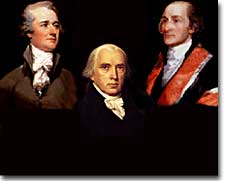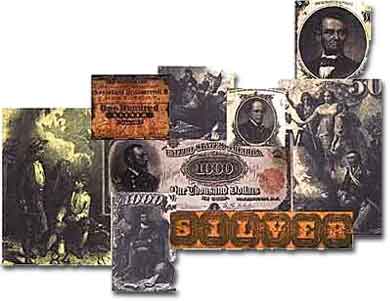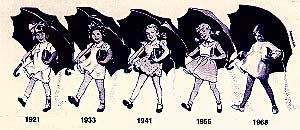3a. The Founders and Federalism

Alexander Hamilton, James Madison, and George Washington were advocates of the federal system.
In their attempt to balance order with liberty, the Founders identified several reasons for creating a federalist government:
- to avoid tyranny
- to allow more participation in politics
- to use the states as "laboratories" for new ideas and programs.
As James Madison pointed out in The Federalist, No. 10, If "factious leaders kindle a flame within their particular states," national leaders can check the spread of the "conflagration through the other states." So federalism prevents a person that takes control of a state from easily taking control of the federal governments as well.
Electing both state and national officials also increases the input of citizens into their government. And if a state adopts a disastrous new policy, at least it would not be a catastrophe for everyone. On the other hand, if a state's new programs work well, other states can adopt their ideas and adjust them to their own needs.
The Constitution gives three types of power to the national government:
1. Delegated (sometimes called enumerated or expressed) powers are specifically granted to the federal government in Article I, Section 8 of the Constitution. This includes the power to coin money, to regulate commerce, to declare war, to raise and maintain armed forces, and to establish a Post Office. In all, the Constitution delegates 27 powers specifically to the federal government.
2. Implied powers are not specifically stated in the Constitution, but may be inferred from the elastic (or "necessary and proper") clause (Article I, Section 8). This provision gives Congress the right "to make all laws which shall be necessary and proper for carrying into execution the foregoing powers, and other powers vested in the government of the United States." Since these powers are not explicit, the courts are often left to decide what constitutes an implied power.
3. Inherent powers are not specifically listed in the Constitution, but they grow out of the very existence of the national government. For example, the United States has the power to acquire territory by exploration and/or occupancy, primarily because most governments in general claim that right.

Article I, Section 8 of the U.S. Constitution authorizes the federal government to issue a central currency for all states. The form of this currency has changed many times through the years.
The Constitution also identifies reserved powers, which are set aside for the states. Unlike delegated powers, they are not listed specifically, but are guaranteed by the Tenth Amendment: "The powers not delegated to the United States by the Constitution, not prohibited by it to the States, are reserved to the States respectively, or to the people." Some traditional reserved powers include regulating trade within a state, establishing local government, and conducting elections.
Some powers of federal and state governments overlap. For example, both may — and do — levy taxes, make and enforce laws, and borrow money. These concurrent powers are not granted exclusively to the national government, nor are they denied the states.

Trademarks such as the Morton Salt umbrella girl are protected by the U.S. Patent and Trademark Office, established to "promote the progress of science and useful arts, by securing for limited times to authors and inventors the exclusive right to their respective writings and discoveries," as stated in Article I, Section 8 of the Constitution.
Prohibited powers are denied either to the national government, state governments, or both (Article I, Section 9.) For example, the national government cannot exercise its powers in such a way as to interfere with the states' abilities to perform their responsibilities. States cannot tax imports or exports, nor can they coin money or issue bills of credit.
States also have responsibilities to one another, as explained in Article IV of the Constitution. One provision is that each state must give "full faith and credit" to the public acts, records, and civil judicial proceedings of every other state. Business contracts, then, are recognized by all states, as are marriages. Extradition, the legal process in which an accused criminal is returned to the state were the crime was committed, is also required by Article IV.
The founders very carefully divided powers between federal and state governments. They were responding to both the colonial aversion to the tyranny of King George III as well as the failure of the Articles of Confederation. Their careful separating and blending of state and national powers guarded against tyranny, allowed for more citizen participation in government, and provided a mechanism for incorporating new policies and programs.







